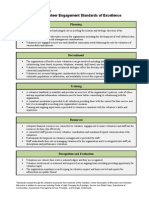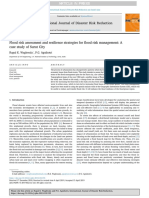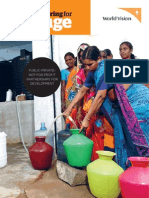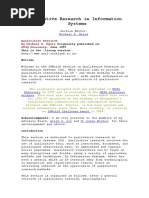0 ratings0% found this document useful (0 votes)
88 viewsQualitative Data Collection Methods
This document summarizes a qualitative research article that studied barriers to male involvement in contraceptive uptake and reproductive health services in Uganda. The study used purposive sampling to collect data through 18 focus group discussions with 154 individuals and 8 key informant interviews. The primary author conducted thematic content analysis of verbatim transcripts in Atlas.ti. The students' own qualitative research experience involved phenomenological design, purposive and criterion sampling of 6 focus groups and 10 key informant interviews. Challenges included large data collection size, while opportunities existed to improve qualitative research skills through this module. Suggestions for the study included clarifying thematic analysis and justifying sample size.
Uploaded by
Yitnet DaginetCopyright
© © All Rights Reserved
Available Formats
Download as PDF, TXT or read online on Scribd
0 ratings0% found this document useful (0 votes)
88 viewsQualitative Data Collection Methods
This document summarizes a qualitative research article that studied barriers to male involvement in contraceptive uptake and reproductive health services in Uganda. The study used purposive sampling to collect data through 18 focus group discussions with 154 individuals and 8 key informant interviews. The primary author conducted thematic content analysis of verbatim transcripts in Atlas.ti. The students' own qualitative research experience involved phenomenological design, purposive and criterion sampling of 6 focus groups and 10 key informant interviews. Challenges included large data collection size, while opportunities existed to improve qualitative research skills through this module. Suggestions for the study included clarifying thematic analysis and justifying sample size.
Uploaded by
Yitnet DaginetCopyright
© © All Rights Reserved
Available Formats
Download as PDF, TXT or read online on Scribd
You are on page 1/ 10
Advanced qualitative method:
Data collection methods reading
reflection
By
Nathan E & Yitagesu H.
Instructor: Dr. Hussen Mekonnen
Outline
• Summary of the article
• Experiences
• Challenges
• Opportunities
• Suggestion to use other tool
• Articles read
• Acknowledgements
8/29/2021 Advanced Qual-Research 2
Summary of the article
• What was the research question ?
– What are barriers to male involvement in
contraceptive uptake and reproductive health
services ?
• Design used: “A cross-sectional qualitative study”
• Sampling strategy : Purposive sampling ?
– current married or non-married partnerships ; men
( 15–54 yrs) and women ( 15–49 yrs)
– key informants ( District health officers, members
of village health teams, council leaders, and
representatives from local women and men’s
groups)
8/29/2021 Advanced Qual-Research 3
Summary of the article
• Data collection ?
– Methods: Interviews and FGDs
• 18 FGDs 154 individuals ??
• 8 Key informant interviews
– Why data saturation took this numbers of
individuals ? The diversity of the research
problem ?
– Tools: Open ended, semi-structured question
guides
– What could have been done if the study team
had found new findings during debriefings ?
8/29/2021 Advanced Qual-Research 4
Summary of the article
• Data Analysis ?
– conducted by the primary author and included
several iterative steps
– Used “thematic content analyses” Why ? And what
is it in the context ?
– Verbatim transcription of discussions and interviews
– Transcripts were coded &managed ATLAS.ti ? Oh !
How ?
– “The grouped categories were refined and used to
generate themes emerging from the data”
8/29/2021 Advanced Qual-Research 5
Our experiences ?
• Qualitative research
• Design : phenomenology
• Sampling strategy: Purposive and criterion
• Sample at data saturation: 6 FGDs and 10 KIIs
• Data analysis- Transcriptions, coding,
categorizing , theming, (creating theoretical
frameworks) ??
8/29/2021 Advanced Qual-Research 6
Challenges and opportunities ??
• Challenges for this articles is may be the data
burden 154 participants in 18 FGDs and 8 KIIs
• What makes surprise to this articles is that
“only primary author did the analysis” that is
why analyst had not at least one non-verbal
action though formal transcription system ?
• For our case too, all the above and other
design issues were very challenging
• This module would be our opportunity to
improve our work
8/29/2021 Advanced Qual-Research 7
Suggestion to the indicated study
• The design mentioned as “A cross-sectional
qualitative study” but better to the best of the
design types
• Sampling strategies are two Purposive sampling
and criterion sampling ?
• “thematic content analyses in the data analysis
section is not clear
• Formal analysis of non-verbal actions should be
analyzed
• The research question of this study would have
been answered with less samples ?
8/29/2021 Advanced Qual-Research 8
Reflecting papers
1. Kabagenyi, A, Jennings L, Reid A, Nalwadda G, Ntozi J,
Atuyambe L. Barriers to male involvement in contraceptive
uptake and reproductive health services: a qualitative study of
men and women’s perceptions in two rural districts in Uganda.
Reproductive Health 2014, 11:21.
8/29/2021 Advanced Qual-Research 9
Acknowledgements
• AAU, SPH for arranging advanced qualitative
research methods the program
• Dr. Mirgissa K, and Dr Hussen M for making
me reflect this interesting topic
8/29/2021 Advanced Qual-Research 10
You might also like
- Mapping Vulnerability Disasters Development and PeNo ratings yetMapping Vulnerability Disasters Development and Pe12 pages
- MANUAL - DaMPeR MODULE 8A PRE-EARTHQUAKE RAPID EVALUATION Rev2019 0115No ratings yetMANUAL - DaMPeR MODULE 8A PRE-EARTHQUAKE RAPID EVALUATION Rev2019 011513 pages
- Social Innovation For Social Cohesion. Findings On Communalities of Innovation From A New Transnational Study.100% (1)Social Innovation For Social Cohesion. Findings On Communalities of Innovation From A New Transnational Study.13 pages
- A Study OnKudumbashree ProjectA Poverty Eradication Programme in Kerala PerformanceNo ratings yetA Study OnKudumbashree ProjectA Poverty Eradication Programme in Kerala Performance67 pages
- Orlando Fals-Borda, Muhammad Anisur Rahman Action and Knowledge Breaking The Monopoly With Participatory Action-Research 1991100% (1)Orlando Fals-Borda, Muhammad Anisur Rahman Action and Knowledge Breaking The Monopoly With Participatory Action-Research 1991193 pages
- A Comparative Study of Prison Systems in African Countries (O.A.Stephens, 2018)No ratings yetA Comparative Study of Prison Systems in African Countries (O.A.Stephens, 2018)374 pages
- Crossing the Finish Line: Completing College at America's Public UniversitiesFrom EverandCrossing the Finish Line: Completing College at America's Public Universities3.5/5 (3)
- Information Marketing in Public LibrariesNo ratings yetInformation Marketing in Public Libraries16 pages
- Collaborative Services in Informal Settlements. A Social Innovation Case in A Paci Ed Favela in Rio de Janeiro100% (1)Collaborative Services in Informal Settlements. A Social Innovation Case in A Paci Ed Favela in Rio de Janeiro15 pages
- Climate Resilient Development Country Framework To Mainstream Climate Risk Management and Adaptation - 2006No ratings yetClimate Resilient Development Country Framework To Mainstream Climate Risk Management and Adaptation - 200662 pages
- Understanding Community Information Needs: Field Research GuideNo ratings yetUnderstanding Community Information Needs: Field Research Guide18 pages
- Mli102 - Management of Library and Information Centres100% (1)Mli102 - Management of Library and Information Centres49 pages
- Village Knowledge Centres: An Initiative of MSSRFNo ratings yetVillage Knowledge Centres: An Initiative of MSSRF4 pages
- WEEK 7 Q2 Policies Addressing Social InequalitiesNo ratings yetWEEK 7 Q2 Policies Addressing Social Inequalities44 pages
- 100 Questions: Identifying Research Priorities For Poverty Prevention and ReductionNo ratings yet100 Questions: Identifying Research Priorities For Poverty Prevention and Reduction10 pages
- Basics of Research Design: A Guide To Selecting Appropriate Research DesignNo ratings yetBasics of Research Design: A Guide To Selecting Appropriate Research Design15 pages
- What Can An Investment Facilitation Agreement at The WTO Do For Sustainable DevelopmentNo ratings yetWhat Can An Investment Facilitation Agreement at The WTO Do For Sustainable Development18 pages
- Advocacy Strategies and Approaches A Resource Manual100% (2)Advocacy Strategies and Approaches A Resource Manual132 pages
- A Framework For Livelihood Analysis: (Frank Ellis)No ratings yetA Framework For Livelihood Analysis: (Frank Ellis)12 pages
- How To Write A Scientific Research Paper - Dr. B.T.LawaniNo ratings yetHow To Write A Scientific Research Paper - Dr. B.T.Lawani9 pages
- Evaluation of The Vulnerable Group Feeding Programme in ZimbabweNo ratings yetEvaluation of The Vulnerable Group Feeding Programme in Zimbabwe44 pages
- Evaluating Your Community Based Program Part I100% (1)Evaluating Your Community Based Program Part I41 pages
- Sustainable Business Model Archetypes For The Banking IndustryNo ratings yetSustainable Business Model Archetypes For The Banking Industry20 pages
- Reflexive Government For Sustainable Davelopment100% (1)Reflexive Government For Sustainable Davelopment477 pages
- Key Issues in Developing and Implementing Youth Policy Strategic DocumentsNo ratings yetKey Issues in Developing and Implementing Youth Policy Strategic Documents54 pages
- Developing A Logical Framework For SMEANo ratings yetDeveloping A Logical Framework For SMEA34 pages
- Unit Five: The Curriculum of Adult and NfeNo ratings yetUnit Five: The Curriculum of Adult and Nfe54 pages
- MSC Research Proposal Template EndowmentNo ratings yetMSC Research Proposal Template Endowment6 pages
- Econometrics in R: Grant V. Farnsworth October 26, 2008No ratings yetEconometrics in R: Grant V. Farnsworth October 26, 200850 pages
- SAMPLE Dissertation Proposal by Adekunle Ilori A50% (2)SAMPLE Dissertation Proposal by Adekunle Ilori A23 pages
- Cost Benefit Analysis 1-Key Concepts (New)No ratings yetCost Benefit Analysis 1-Key Concepts (New)10 pages
- The Tutor/Mentor Business, by Sara Coover Caldwell. The Story of One Person's Effort To Create ChangeNo ratings yetThe Tutor/Mentor Business, by Sara Coover Caldwell. The Story of One Person's Effort To Create Change18 pages
- Intervention Mapping - A Process For Developing Theory and Evidence BasedNo ratings yetIntervention Mapping - A Process For Developing Theory and Evidence Based20 pages
- Echoes of Exclusion and Resistance: Voices from the Hanford RegionFrom EverandEchoes of Exclusion and Resistance: Voices from the Hanford RegionNo ratings yet
- Health History Rubric Task Poor (1pt) Fair (2pts) Good (3pts) Excellent (4pts) ScoreNo ratings yetHealth History Rubric Task Poor (1pt) Fair (2pts) Good (3pts) Excellent (4pts) Score2 pages
- Letter Formats - Offer, Confirmation, Joining, Etc.No ratings yetLetter Formats - Offer, Confirmation, Joining, Etc.11 pages
- Statistical Officer Job Description - Docxv2 R1 2014No ratings yetStatistical Officer Job Description - Docxv2 R1 20144 pages
- Responsible Conduct of Research 3rd Edition Adil E. Shamoo 2024 Scribd Download100% (5)Responsible Conduct of Research 3rd Edition Adil E. Shamoo 2024 Scribd Download84 pages
- Đề Thi Môn Tiếng Anh: Sở Gd&Đt Hòa Bình NĂM HỌC 2022-2023 (No ratings yetĐề Thi Môn Tiếng Anh: Sở Gd&Đt Hòa Bình NĂM HỌC 2022-2023 (3 pages
- Crenshaw Et Al (2017) - Revised Scoring For The Communication Patterns QuestionnaireNo ratings yetCrenshaw Et Al (2017) - Revised Scoring For The Communication Patterns Questionnaire16 pages
- Jonathan Sokolow For Bernie Sanders National DelegateNo ratings yetJonathan Sokolow For Bernie Sanders National Delegate2 pages
- Other Ways To Express Future - Grammar ChartNo ratings yetOther Ways To Express Future - Grammar Chart5 pages
- Equivalent Citation: 2007 (4) ALD11 (SC), 2007 (3) ALT62 (SC), 2007 (2) BLJR1047, 2007No ratings yetEquivalent Citation: 2007 (4) ALD11 (SC), 2007 (3) ALT62 (SC), 2007 (2) BLJR1047, 200720 pages
- 5 Signs Your Equipment Needs CalibrationNo ratings yet5 Signs Your Equipment Needs Calibration6 pages
- Community Engagement, Solidarity and CitizenshipNo ratings yetCommunity Engagement, Solidarity and Citizenship51 pages
- Answer The Phone. He Promised To Be Home by 10 P.M. However, We100% (1)Answer The Phone. He Promised To Be Home by 10 P.M. However, We2 pages
- Mapping Vulnerability Disasters Development and PeMapping Vulnerability Disasters Development and Pe
- MANUAL - DaMPeR MODULE 8A PRE-EARTHQUAKE RAPID EVALUATION Rev2019 0115MANUAL - DaMPeR MODULE 8A PRE-EARTHQUAKE RAPID EVALUATION Rev2019 0115
- Social Innovation For Social Cohesion. Findings On Communalities of Innovation From A New Transnational Study.Social Innovation For Social Cohesion. Findings On Communalities of Innovation From A New Transnational Study.
- A Study OnKudumbashree ProjectA Poverty Eradication Programme in Kerala PerformanceA Study OnKudumbashree ProjectA Poverty Eradication Programme in Kerala Performance
- Orlando Fals-Borda, Muhammad Anisur Rahman Action and Knowledge Breaking The Monopoly With Participatory Action-Research 1991Orlando Fals-Borda, Muhammad Anisur Rahman Action and Knowledge Breaking The Monopoly With Participatory Action-Research 1991
- A Comparative Study of Prison Systems in African Countries (O.A.Stephens, 2018)A Comparative Study of Prison Systems in African Countries (O.A.Stephens, 2018)
- Crossing the Finish Line: Completing College at America's Public UniversitiesFrom EverandCrossing the Finish Line: Completing College at America's Public Universities
- Collaborative Services in Informal Settlements. A Social Innovation Case in A Paci Ed Favela in Rio de JaneiroCollaborative Services in Informal Settlements. A Social Innovation Case in A Paci Ed Favela in Rio de Janeiro
- Climate Resilient Development Country Framework To Mainstream Climate Risk Management and Adaptation - 2006Climate Resilient Development Country Framework To Mainstream Climate Risk Management and Adaptation - 2006
- Understanding Community Information Needs: Field Research GuideUnderstanding Community Information Needs: Field Research Guide
- Mli102 - Management of Library and Information CentresMli102 - Management of Library and Information Centres
- 100 Questions: Identifying Research Priorities For Poverty Prevention and Reduction100 Questions: Identifying Research Priorities For Poverty Prevention and Reduction
- Basics of Research Design: A Guide To Selecting Appropriate Research DesignBasics of Research Design: A Guide To Selecting Appropriate Research Design
- What Can An Investment Facilitation Agreement at The WTO Do For Sustainable DevelopmentWhat Can An Investment Facilitation Agreement at The WTO Do For Sustainable Development
- Advocacy Strategies and Approaches A Resource ManualAdvocacy Strategies and Approaches A Resource Manual
- A Framework For Livelihood Analysis: (Frank Ellis)A Framework For Livelihood Analysis: (Frank Ellis)
- How To Write A Scientific Research Paper - Dr. B.T.LawaniHow To Write A Scientific Research Paper - Dr. B.T.Lawani
- Evaluation of The Vulnerable Group Feeding Programme in ZimbabweEvaluation of The Vulnerable Group Feeding Programme in Zimbabwe
- Sustainable Business Model Archetypes For The Banking IndustrySustainable Business Model Archetypes For The Banking Industry
- Key Issues in Developing and Implementing Youth Policy Strategic DocumentsKey Issues in Developing and Implementing Youth Policy Strategic Documents
- Econometrics in R: Grant V. Farnsworth October 26, 2008Econometrics in R: Grant V. Farnsworth October 26, 2008
- The Tutor/Mentor Business, by Sara Coover Caldwell. The Story of One Person's Effort To Create ChangeThe Tutor/Mentor Business, by Sara Coover Caldwell. The Story of One Person's Effort To Create Change
- Intervention Mapping - A Process For Developing Theory and Evidence BasedIntervention Mapping - A Process For Developing Theory and Evidence Based
- Echoes of Exclusion and Resistance: Voices from the Hanford RegionFrom EverandEchoes of Exclusion and Resistance: Voices from the Hanford Region
- Health History Rubric Task Poor (1pt) Fair (2pts) Good (3pts) Excellent (4pts) ScoreHealth History Rubric Task Poor (1pt) Fair (2pts) Good (3pts) Excellent (4pts) Score
- Letter Formats - Offer, Confirmation, Joining, Etc.Letter Formats - Offer, Confirmation, Joining, Etc.
- Statistical Officer Job Description - Docxv2 R1 2014Statistical Officer Job Description - Docxv2 R1 2014
- Responsible Conduct of Research 3rd Edition Adil E. Shamoo 2024 Scribd DownloadResponsible Conduct of Research 3rd Edition Adil E. Shamoo 2024 Scribd Download
- Đề Thi Môn Tiếng Anh: Sở Gd&Đt Hòa Bình NĂM HỌC 2022-2023 (Đề Thi Môn Tiếng Anh: Sở Gd&Đt Hòa Bình NĂM HỌC 2022-2023 (
- Crenshaw Et Al (2017) - Revised Scoring For The Communication Patterns QuestionnaireCrenshaw Et Al (2017) - Revised Scoring For The Communication Patterns Questionnaire
- Jonathan Sokolow For Bernie Sanders National DelegateJonathan Sokolow For Bernie Sanders National Delegate
- Equivalent Citation: 2007 (4) ALD11 (SC), 2007 (3) ALT62 (SC), 2007 (2) BLJR1047, 2007Equivalent Citation: 2007 (4) ALD11 (SC), 2007 (3) ALT62 (SC), 2007 (2) BLJR1047, 2007
- Answer The Phone. He Promised To Be Home by 10 P.M. However, WeAnswer The Phone. He Promised To Be Home by 10 P.M. However, We

























































































